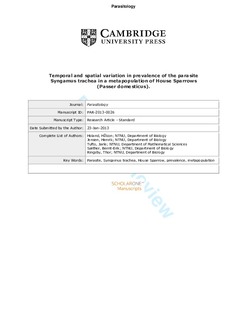| dc.contributor.author | Holand, Håkon | |
| dc.contributor.author | Jensen, Henrik | |
| dc.contributor.author | Tufto, Jarle | |
| dc.contributor.author | Sæther, Bernt-Erik | |
| dc.contributor.author | Ringsby, Thor Harald | |
| dc.date.accessioned | 2017-10-30T12:41:37Z | |
| dc.date.available | 2017-10-30T12:41:37Z | |
| dc.date.created | 2013-09-30T13:48:26Z | |
| dc.date.issued | 2013 | |
| dc.identifier.citation | Parasitology. 2013, 140 (10), 1275-1286. | nb_NO |
| dc.identifier.issn | 0031-1820 | |
| dc.identifier.uri | http://hdl.handle.net/11250/2462887 | |
| dc.description.abstract | When investigating parasite–host dynamics in wild populations, a fundamental parameter to investigate is prevalence. This quantifies the percentage of individuals infected in the population. Investigating how prevalence changes over time and space can reveal interesting aspects in the parasite–host relationship in natural populations. We investigated the dynamic between a common avian parasite (Syngamus trachea) in a host metapopulation of house sparrows (Passer domesticus) on the coast of Helgeland in northern Norway. We found that parasite prevalence varied in both time and space. In addition, the parasite prevalence was found to be different between demographic groups in the local populations. Our results reveal just how complex the dynamic between a host and its parasite may become in a fragmented landscape. Although temperature may be an important factor, the specific mechanisms causing this complexity are not fully understood, but need to be further examined to understand how parasite–host interactions may affect the ecological and evolutionary dynamics and viability of host populations. | nb_NO |
| dc.language.iso | eng | nb_NO |
| dc.publisher | Cambridge University Press (CUP) | nb_NO |
| dc.title | Temporal and spatial variation in prevalence of the parasite Syngamus trachea in a metapopulation of House Sparrows (Passer domesticus) | nb_NO |
| dc.type | Journal article | nb_NO |
| dc.description.version | submittedVersion | nb_NO |
| dc.source.pagenumber | 1275-1286 | nb_NO |
| dc.source.volume | 140 | nb_NO |
| dc.source.journal | Parasitology | nb_NO |
| dc.source.issue | 10 | nb_NO |
| dc.identifier.doi | 10.1017/S0031182013000735 | |
| dc.identifier.cristin | 1053868 | |
| dc.relation.project | Norges forskningsråd: 221956 | nb_NO |
| dc.relation.project | Norges forskningsråd: 204303 | nb_NO |
| dc.relation.project | Norges forskningsråd: 223257 | nb_NO |
| dc.description.localcode | This is a submitted manuscript of an article published by Cambridge University Press in Parasitology, 21 June 2013 | nb_NO |
| cristin.unitcode | 194,66,10,0 | |
| cristin.unitcode | 194,63,15,0 | |
| cristin.unitname | Institutt for biologi | |
| cristin.unitname | Institutt for matematiske fag | |
| cristin.ispublished | true | |
| cristin.fulltext | preprint | |
| cristin.qualitycode | 1 | |
